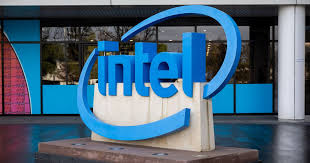Business
商業(yè)版塊
Intel
英特爾
Hard reboot
硬重啟
Can Pat Gelsinger turn the chipmaking giant around?
帕特·蓋爾辛格能扭轉(zhuǎn)芯片制造業(yè)巨頭英特爾的頹勢嗎?
“Success breeds complacency. Complacency breeds failure. Only the paranoid survive.” So said Andy Grove, the Hungarian emigre who helped turn Intel from a scrappy startup in the 1960s into the firm that did more than any other to put the “silicon” in Silicon Valley. They will be ringing in the ears of Pat Gelsinger, Intel’s new boss, who took over on February 15th. He takes the helm of a company that looks, from some angles, to be in rude health. With $78bn in revenue in 2020, it is the world’s biggest chipmaker by sales. It has a 93% share of the market for powerful—and lucrative—chips that go into data-centre computers, an 81% share in desktop pcs, and operating margins of around 30%.
“成功滋生自滿,自滿導致失敗,只有多慮之人才能生存下去。”匈牙利移民安迪·格魯夫如是說。安迪·格魯夫幫助上世紀60年代時破敗的初創(chuàng)公司英特爾搖身一變成為無出其右的硅谷本“硅”。他的這番話將繼續(xù)在2月15日上任的英特爾新老板帕特·蓋爾辛格的耳邊回響。從某些角度來看,帕特·蓋爾辛格執(zhí)掌之下的英特爾狀態(tài)穩(wěn)健。英特爾2020年營收為780億美元,是全球銷量最大的芯片制造商。關(guān)于功能強大且利潤豐厚的芯片市場,因特爾在計算機數(shù)據(jù)中心市場占有93%的份額,在臺式電腦市場占有81%的份額,運營利潤率在30%左右。

Yet Intel’s share price has underperformed those of rivals. Nvidia, a firm with one-seventh of Intel’s revenues, has a market capitalisation, at $370bn, that is half as high again. The manufacturing technology on which much of Intel’s success was built has fallen behind. It has missed the smartphone revolution. Some of its big customers, such as Apple and Amazon, are turning into competitors. Mr Gelsinger inherits quite the in-tray, then.
然而,英特爾的股價卻遜于競爭對手。營收只有英特爾的七分之一的英偉達公司市值高達3700億美元,是英特爾的一半。英特爾能夠成功所依靠的大部分的芯片制造技術(shù)已經(jīng)落后。它錯過了智能手機革命。它的一些大客戶,如蘋果和亞馬遜,正在變成其競爭對手。基爾辛格相當于接過了燙手的山芋。
Start with production. Chipmaking is propelled by the quest for smallness. Shrinking the components in integrated circuits, these days to tens of nanometres (billionths of a metre), improves the performance of both the components and the microchip as a whole. For decades Intel led the way, its “Tick-tock” strategy promising a manufacturing revolution every other year. Now “it has lost its mojo,” says Alan Priestley of Gartner, a research firm, who worked at Intel for many years. Its “ten nanometre” chips were originally pencilled in for 2015 or 2016 but did not start trickling out until 2019—an unprecedented delay. The technology is still not mature. In July Intel said the next generation of “seven nanometre” chips would not arrive until 2022, a delay of at least six months.
先從生產(chǎn)開始。芯片制造受到對尺寸小型化追求的推動。如今,將集成電路中的組件尺寸縮小到幾十納米(十億分之一米)級,提高了組件和整個芯片的性能。幾十年來,英特爾一直處于領(lǐng)先地位,其“Tick-tock”戰(zhàn)略承諾每隔一年就要進行一次制造業(yè)革命。咨詢公司高德納的艾倫·普里斯特利曾在英特爾工作多年,他說,“英特爾已經(jīng)失去了昔日的輝煌”。它的“10納米”芯片原本計劃在2015年或2016年推出,但直到2019年才開始陸續(xù)問世,這是前所未有的延遲。這項技術(shù)也還不成熟。7月,英特爾表示,下一代“7納米”芯片要到2022年才能問世,又是至少6個月的延遲。
譯文由可可原創(chuàng),僅供學習交流使用,未經(jīng)許可請勿轉(zhuǎn)載。











